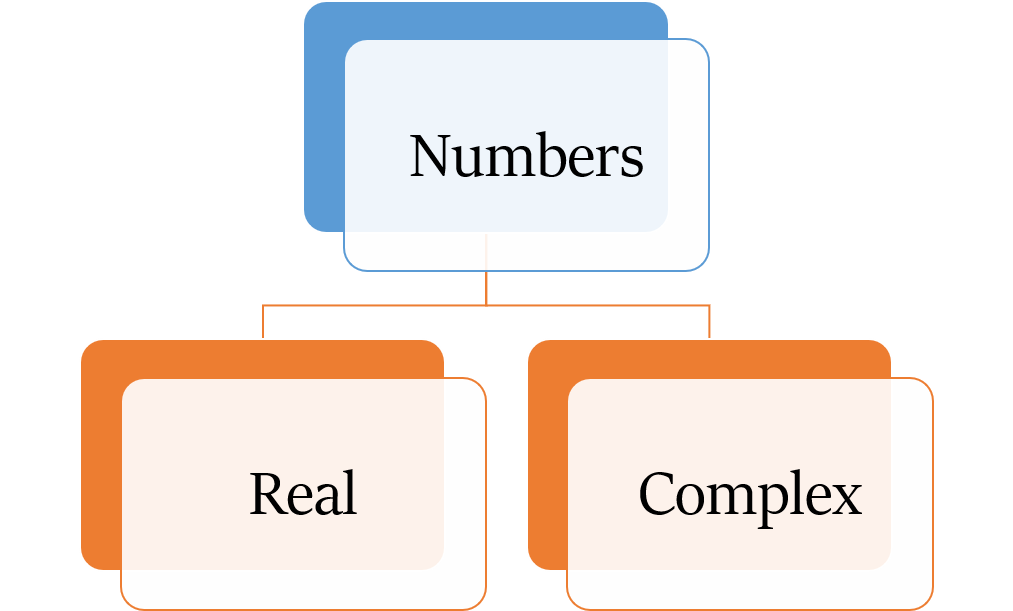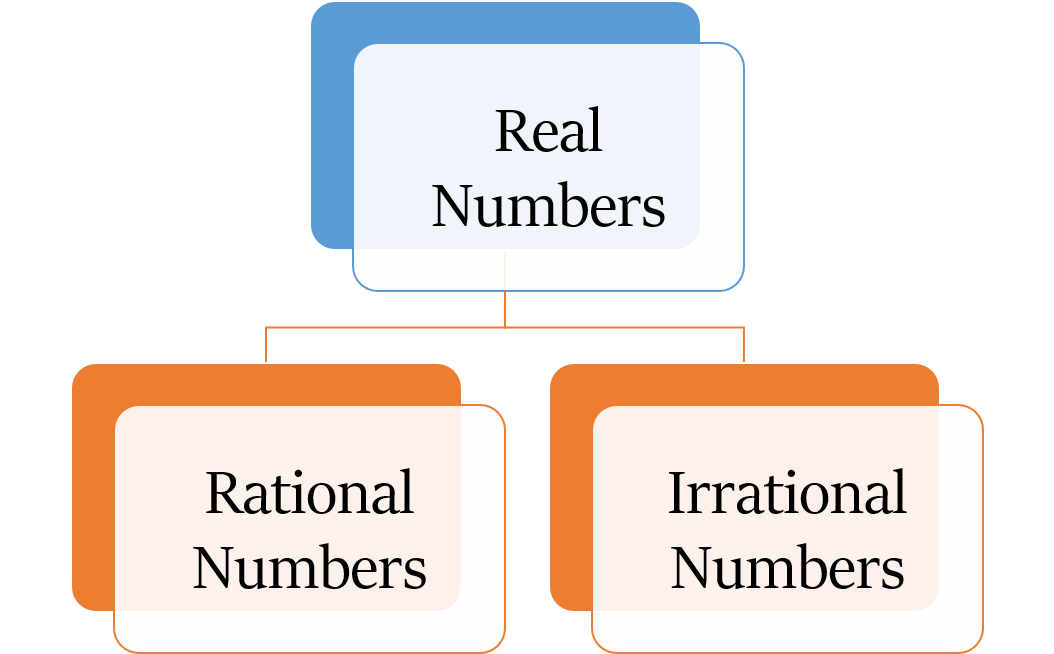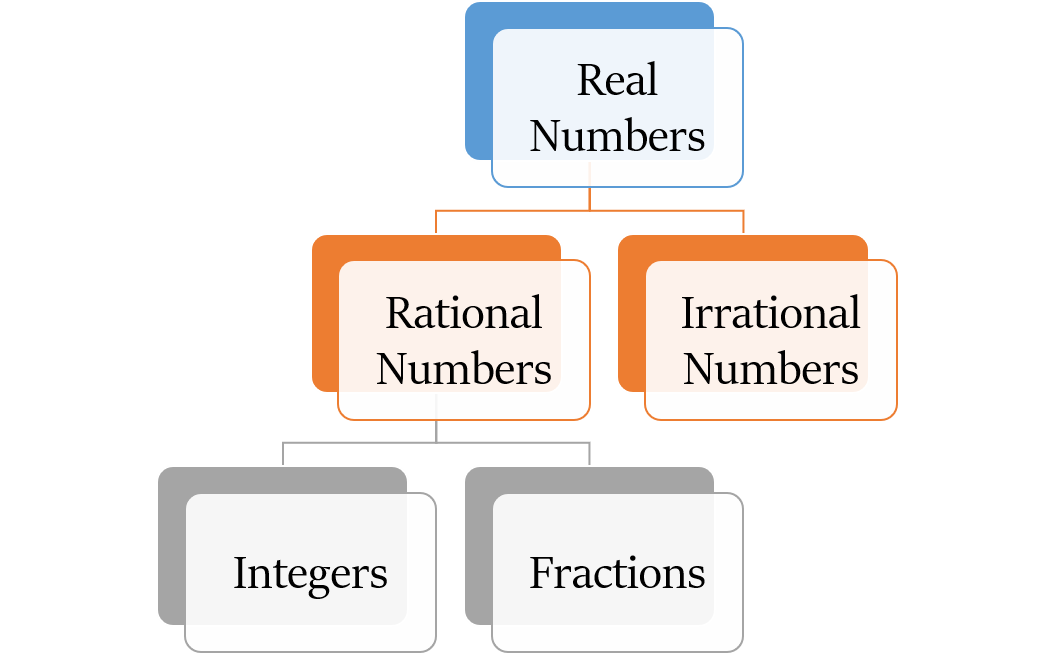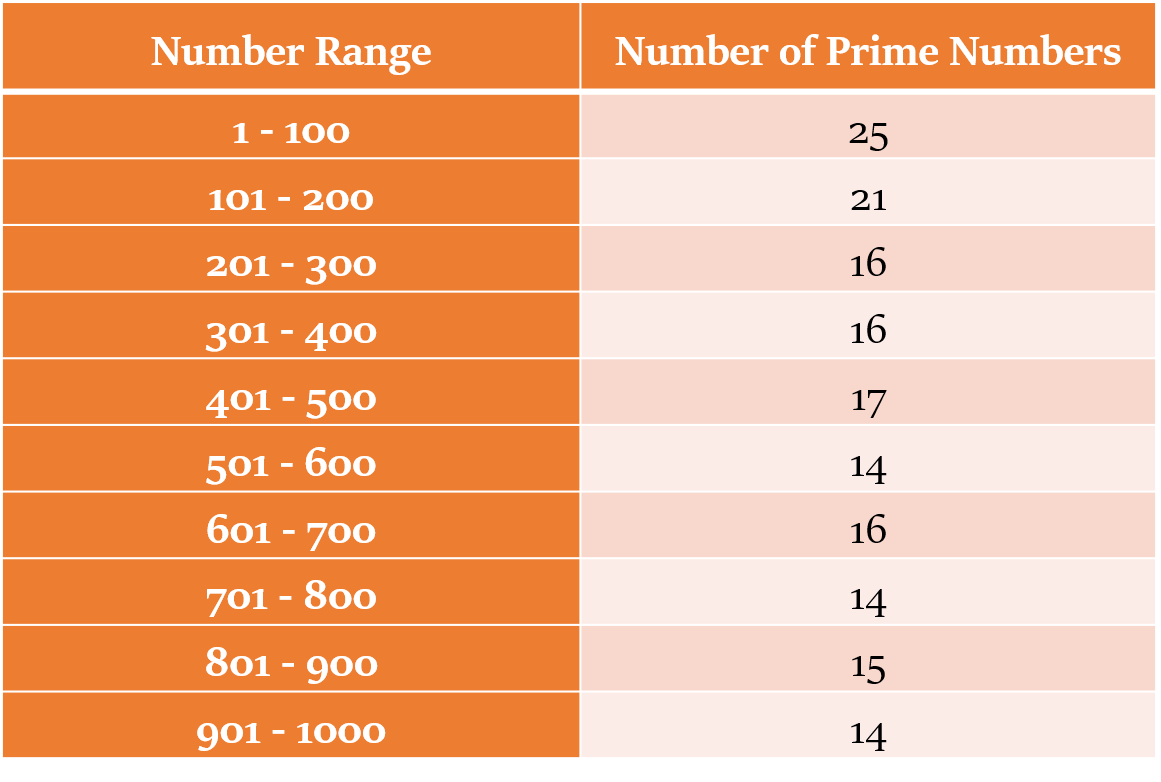Types of Numbers
In this module we will learn about the various Types of Numbers.
Real and Complex Numbers
Numbers can be classified into two major groups: Real and Complex Numbers.

Real Numbers
They are all the numbers on the number line. In other words a real number is any number which is not an imaginary number.
Complex Numbers
Complex numbers are of the form a + bi, where a and b are the real numbers and i is the imaginary unit whose value is √-1.
The solutions of equations of the form
Types of Real Numbers
Real Numbers may be divided into two categories: Rational and Irrational numbers.

This categorization may be done on the basis of two concepts.
Ability to be represented in terms of Fraction
Rational Numbers
A number which can be represented in the form of p/q, where p & q are integers & q is not equal to 0.
E.g. 3/5, -5/8 etc.
For example, 9 is a rational number since 9 can be written as 9/1 where 9 and 1 are integers and the denominator 1 ≠ 0.
Irrational Numbers
A number which cannot be expressed in the form of p/q, but can be represented by a point on the number line.
E.g. √2 = 1.414, 1.46378, π, e etc.
Based on termination & recurrence
Here’s another way of looking at rational and irrational numbers:
Rational Numbers
They are:
- integers (E.g. 2, 18, -6) or
- fractions that are terminating (Eg: 0.2, 1.25) or
- fractions that are recurring (Eg: 0.33333…, 0.16666)
A recurring decimal is a number in which one or more digits at the end of a number after the decimal point repeats endlessly.
Just like a terminating decimal number, any recurring decimal number can also be expressed in the form p/q, i.e. as a fraction.
Irrational Number
They are non-terminating and non-recurring in nature.
E.g. √2, √5, ∛10, π etc.
Other classifications of Real Numbers
Apart from Rational and Irrational classification, Numbers can also be divided into the following types:
Positive Numbers: Number which are to the right of zero on the number line.
Example: 0.9, 1, 2, 3.2, 1.414 etc.Negative Numbers: Numbers which are to the left of zero on the number line.
Example: -0.9, -1, -3, -9.2, -1.414 etc.
Properties of Real Numbers
We get a real number when we add or multiply two real numbers. The order is not important.
Two real numbers cannot be subtracted or divided in either order, i.e. subtraction and division of real numbers are not commutative.
We don’t define square root of negative real numbers.
Properties specific to Rational Numbers
Sum, difference, product, and quotient of any two given rational numbers is also a rational number (as long as we don’t divide by 0).
Between any two numbers, there can be infinite number of other rational numbers.
Properties specific to Irrational Numbers
Irrational numbers can be further subdivided into:
a. algebraic numbers – they are the solutions of some polynomial equation (e.g. √2 and the golden ratio), and
b. transcendental numbers – they are not the solutions of any polynomial equation (e.g. π and e).Between any two numbers, there are infinite number of irrational numbers.
Rational Numbers
We have already seen that Rational Numbers are Real Numbers.
Also, Rational Numbers can be either terminating (Eg: 0.2, 1.25) or recurring (Eg: 0.33333…, 0.16666). And both can be represented as a fraction.
But how will we identify whether a given fraction is terminating or recurring?
How to identify if a fraction gives terminating decimal or recurring decimal?
Terminating decimal - If the denominator of the simplified form of a fraction consists of only prime factors 2 or 5.
OR
Recurring decimal - If the denominator of the simplified form of a fraction consists of at least one factor other than 2 or 5.
Let us see an example.
Which among the following fractions is/are recurring decimal?
271/128, 203/125, 321/200, 431/150
Let us check the prime factors of the denominators.
128 =
125 =
200 = 2^3 ×
150 = 2 × 3 ×
All these denominators have the prime factors 2 or 5 only, except 150. 150 has 3 too as a prime factor. So, only 431/150 is the recurring decimal. Rest are terminating decimals.
Now, let us study Recurring Decimals in a little more detail.
Recurring Decimals
Recurring Decimal - A decimal in which a digit or a set of digits is repeated continuously.
Recurring decimals can be written in a shortened form, by placing a bar over the digits which are repeated.
E.g. 1/7 = 0.142857142857142857….. = 0.
In the above decimal, the set of digits 142857 is recurring. So, we placed a bar over the entire set of the digits that recur.
Two types of Recurring Decimals
Pure recurring decimal - all the digits after the decimal point are recurring.
E.g. 0.666666…Mixed recurring decimal - some of the digits after the decimal are not recurring.
E.g. 0.1666666… (in this case, only the digit 6 is recurring, while the digit 1 is not recurring).
Converting Recurring decimals into fraction
We will see how to convert pure and mixed recurring decimal numbers into fractions separately. There is a minor difference between the two approaches.
Converting pure recurring decimal into fraction
To convert a pure recurring decimal into a fraction:
Numerator of the fraction = a number formed by the recurring digits (called the period of the decimal)
Denominator of the fraction = a number which has as many nines as there are digits in the recurring digits.
E.g. 0.
0.
Q. Express 0.7777… as a fraction.
Explanations :
Let x = 0.7777…
As the period is of one digit, we will multiply the given number by 10.
So, 10x = 7.777…
Hence, 10x – x = 7.777… - 0.7777…
Or 9x = 7
Or x = 7/9
Converting mixed recurring decimal into fraction
To convert a mixed recurring decimal into a fraction:
Numerator of the fraction = a number formed by the recurring and non-recurring digits – part of the decimal that is not recurring
Denominator of the fraction = a number which has as many nines as there are digits in the recurring digits and thereafter as many zeroes as there are digits in the non-recurring part.
E.g. 0.2
Q. Express 0.27777… as a fraction.
Explanations :
Let x = 0.27777…
As there is only one non-recurring digit, we will multiply the given number by 10.
So, 10x = 2.7777… = 2 + 0.7777… = 2 + 7/9 (since 0.7777 = 7/9) = 25/9
Or x = 25/90 = 5/18
Integers
We already know that:
- Rational numbers may be classified in two groups: Integers and Fractions

- Rational fractions may be either terminating or recurring.
We have already studied the rational fractions in detail. Now, let us focus on Integers.
What are Integers?
In short, integers are rational numbers. (and rational numbers are real numbers)
Well, we can say that integers are those rational numbers of the form p/q, wherein q = 1.
E.g. 3 = 3/1, -5 = -5/1 etc.
All the positive and negative numbers lying on the number line (including zero) are Integers.
A set of integers is denoted by the letter ‘Z’.
So, Z = { …..-4, -3, -2, -1, 0, 1, 2, 3, 4…..}.
Properties of Integers
The sum, product, and difference of any two integers is also an integer.
E.g. 2 + 4 = 6 (an integer)
3 × 5 = 15 (an integer)
-4 + 1 = -3 (an integer)But this is not necessarily true for division.
E.g. 4/1 = 4 (an integer)
1/3 = 0.3333 (not an integer)
Now, let us see the various classifications of Integers.
Various Classifications of Integers
Natural and Whole Numbers
Natural Numbers: Integers on the number line from 1 onwards.
It is denoted by N.
Example: 1, 2, 3, 4, …. etc.Whole Numbers (Non-negative integers): Integers on the number line from 0 onwards.
When we include ‘zero’ in the natural numbers, it is known as whole numbers.
Example: 0, 1, 2, 3, 4, …… etc.
Properties of Natural Numbers
Sum: The sum of any two natural numbers is also a natural number.
E.g. 18 + 22 = 40Product: The product of any two natural numbers is a natural number.
E.g. 18 × 2 = 36
But this is not true for subtraction and division.Subtraction: The subtraction of any two natural numbers may or may not be a natural number.
E.g. 22 – 18 = 4 (a natural number)
18 – 22 = -4 (not a natural number)Division: The division of any two natural numbers may or may not be a natural number.
E.g. 22/2 = 11 (a natural number)
22/4 = 5.5 (not a natural number)
Even and Odd
- Even Number: Any integer which is divisible by 2 (including zero).
It can be represented by 2n (where n is an integer).
For example: 0, 2, 4, 6, 8, 10, -2, -4, etc.
- Odd Number: Any integer which is not divisible by 2.
It can be represented by 2n + 1 (where n is an integer).
For example:- 1, 3, 9, 13, -1, -3, -5 etc.
Properties of odd and even numbers
Property I: Addition
Case I: Sum of any number of even numbers is even.
E.g. 2 + 4 = 6; 2 + 4 + 6 = 12Case II: Sum of odd number of odd numbers is odd. E.g. 1 + 3 + 5 = 9.
Sum of even number of odd numbers is even. E.g. 1 + 3 = 4.Case III: When odd and even numbers are added, then:
a) the sum is odd: when there is odd number of odd numbers.
b) the sum is even: when there is even number of odd numbers.
Property II: Subtraction
Case I: Difference of two even numbers is always even.
E.g. 4 – 2 = 2Case II: Difference of two odd numbers is always even.
E.g. 7 – 3 = 4Case III: Difference of one odd and one even number is always odd.
E.g. 9 – 4 = 5
If sum of two numbers is odd, then their subtraction will also be odd.
E.g. 7 + 4 = 11; So, 7 – 4 = 3
If sum of two numbers is even, then their subtraction will also be even.
E.g. 8 + 6 = 14; So, 8 – 6 = 2
Property III: Multiplication
Case I: Product of all odd numbers is odd.
E.g. 5 × 7 = 35Case II: Product of all even numbers or product of odd and even numbers is even.
E.g. 4 × 8 = 32; 3 × 6 = 18
Property IV: Division
We will consider the cases where the numerator is a multiple of denominator.
Case I: If the numerator is even and denominator is odd, then the result is always an even number.
E.g. 18/3 = 6.Case II: If both the numerator and denominator are even, then the result may be even or odd.
E.g. 20/5 = 4; 18/6 = 3.Case III: If the numerator is odd and denominator is even, then the numerator cannot be a multiple of the denominator. So, the result will not be an integer, but rather a fraction.
Case IV: If the numerator is odd and denominator is odd, then the result is always odd.
E.g. 27/3 = 9.
Prime and Composite
Prime Numbers: A positive number (except 1) divisible only by ‘1’ and ‘itself’.
E.g. 2, 3, 5, 7, 11, 13, …… etc.Composite Numbers: All integers (except 1) which are not prime.
They are called composite because they are composed of two or more prime numbers. So, a composite number has factors other than 1 and itself.
- 1 is neither prime nor composite.
- 2 is the smallest prime number and the only prime number which is even. All other prime numbers are odd.
There are 25 prime numbers between 1-100.

How to identify a prime number?
There are a couple of methods to check if a number is prime number or not.
Method I
- Step 1: Write down the given number.
- Step 2: Find the next number which is a perfect square.
- Step 3: Find the square root of this number.
- Step 4: Find out all the prime numbers less than the number got in step 3.
- Step 5: If any of the prime numbers found out in step 4 divides the given number, the given number will not be a prime number, otherwise it will be a prime number.
Method II
- Step 1: Find all the factors of the number.
- Step 2: If the number has only two factors, 1 and itself, then it is a prime number.
- Step 3: If the number has more than these two factors, then it is a composite number.
Properties of prime numbers
Property 1: Generic expression for Prime numbers
All prime numbers greater than 3 can be expressed in the form of 6n – 1 or 6n + 1 (where n is a natural number), i.e. they leave remainder 1 or 5 when divided by 6.
E.g. 11 = (6 × 2) – 1
13 = (6 × 2) + 1
But keep in mind that the other way round is not always true. All the numbers which are in the forms 6n – 1 or 6n + 1 are not necessarily always prime.
E.g. when n = 4, 6n + 1 = 25 (not a prime number)
When n = 8, 6n + 1 = 49 (not a prime number)
Property 2: Twin Primes
Twin Primes – when any two consecutive odd numbers are prime.
Eg. (3, 5), (5, 7), (11, 13), (17,19), etc.
Property 3: Prime triplet
Prime triplet – when three consecutive odd numbers are prime.
There is only one prime triplet - (3, 5, 7).
Property 4: Arithmetic Progression
Some set of prime numbers can be in Arithmetic Progression.
E.g. 11, 17, 23, 29 (common difference of 6)